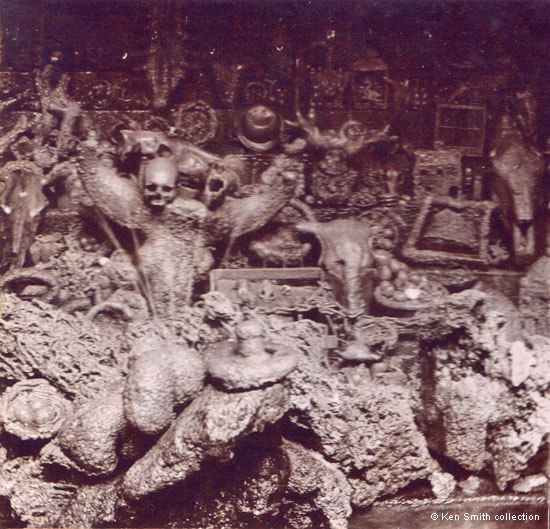As well as the usual array of small objects, such as birds' nests, eggs, fruit, vases, and hats, this stereoview indicates
that some slightly unexpected things were also popular souvenirs for nineteenth century visitors to the petrifying
wells of Matlock Bath. The enlargement below shows that amongst the numerous items in the display were antlers
and a cow's head, as well as one of a horse and another that was possibly a donkey, all undergoing petrifaction.
There also seem to be two small skulls, one of a monkey and one that may or may not have been a very small human.
It is difficult to know. There is also a chain. However, the items photographer indicate this was taken at the Great Petrifying
Well, for a time run by William Smedley and John Ogden and after Smedley's death by John Ogden.
As the petrification process took up to a year to complete, and sometimes longer, some people sent whatever they wanted
to be turned into stone to the petrifactioners rather than delivering the item in person.
An 1870s advertisement placed by Jacob Raynes, a Lessee, stated that "The only ROYAL PETRIFYING WELL is
on the High road leading to Cromford, and is the second well, known as "Jacob's Well". It was from this well that
her most Gracious Majesty when a girl chose a bird's nest"; the well was not leased by Raynes at the time. However, his 'terms were "Reasonable" and he welcomed
both excursionists and school parties in the 1870s[1].
Matlock Bath was visited by thousands of excursionists at holiday
times in the mid to late nineteenth century and its regular
season visitors were also numerous[2].
Touting became a real problem and
the more discerning visitors were starting to make unfavourable
comments in both the press and guide books[3].
Cavern guides, cab drivers and petrifactioners all tried
to out-shout each other in an effort to entice visitors to
their particular attraction or mode of transport. Matlock
Bath's Local Board expressed grave concern about what was
going on in 1892. The Board had thought that the issue had
gone away but found that leaflets were starting to replace
the shouting, thus creating a litter problem. They were determined
to deal with things as best they could. "Mr Buxton remarked
that the greatest annoyance was from the petrifying wells,
where they were calling out a thousand times a day. At the
well near his house and on the other side of his premises
the shouting was awful. There was a regular obstruction and
people were touting every day"[4].
It must have been extremely unpleasant to live next door to.

You may like to view more onsite information
 Gem of the Peak (1840) - read the section on "What
to do in 1840" as there is more information about petrifying wells (scroll down). Gem of the Peak (1840) - read the section on "What
to do in 1840" as there is more information about petrifying wells (scroll down).
 Bemroses' Guide to Matlock ... , about 1869, p.16 Bemroses' Guide to Matlock ... , about 1869, p.16
 Also see the transcript of Croston's "On Foot Through
the Peak". Chapter 14 provides an interesting description of the petrification process (paras 5, 6 and 7) Also see the transcript of Croston's "On Foot Through
the Peak". Chapter 14 provides an interesting description of the petrification process (paras 5, 6 and 7)
 Matlock Bath's Main Attractions Matlock Bath's Main Attractions
 Read a poem about a Fenland market town's request for unusual items to be petrified in 1902. Read a poem about a Fenland market town's request for unusual items to be petrified in 1902.
 Nineteenth century directories give the names of petrifactioners Nineteenth century directories give the names of petrifactioners
 There is more information about the process in the FAQs There is more information about the process in the FAQs
|
References (coloured links are to transcripts or more information elsewhere on
this web site):
[1] Raynes' advertisement appeared in many issues of the "Derbyshire
Times", although this quote was from the edition of 3 August 1872. Raynes meant Queen Victoria.
[2] "Derbyshire Times", 15 Jul 1882.
[3] A few years later, in 1908, J. B. Firth, was extremely frank about how unpleasant things
had become in his book "Highways and Byways in Derbyshire", MacMillan & Co., London.
[4] "Derbyshire Times", 18 June 1892. Mr. Herbert Buxton owned both a Museum and the
Switchback Railway.
|